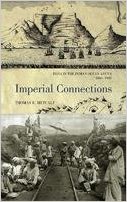Metcalf’s new book charts a new course. If in line with his earlier books like Ideology of the Raj and Imperial Visions, the scope and range of this one are different. It shows how the Indian Ocean area formed a sub-empire under the British, where India had the dubious distinction of being at the centre and an active agent of the empire. This model of a web, where the interconnections are seen as not always mediated through the centre, helps in correcting the distortions in the Eurocentric gaze of the British Empire. It appreciates the complexity in the relations among the different constituents of the empire and sees India as one of the knots in the web, but with a definitively central position. This is clearly a better way of looking at them than in the simple model of a wheel, with each of the unconnected colonies located at the circumference and connected with the hub by so many spokes, the relations between the metropolitan capital and the subject territories regulated directly.
Metcalf’s meticulous research, using an archive spread over many countries in three continents, and in publications related to a wide variety of fields, has paid its rich dividends in this tour de force of his sustained work in Indian historiography.
In this exercise of ‘re-centering’ the empire, Metcalf begins by showing how India stood, both cartographically and in effect, at the centre of the British Empire in the Indian Ocean area. From Cape Town in South Africa to Jakarta in Indonesia

